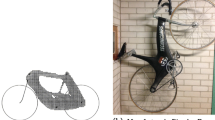Abstract
In recent years, the Evolutionary Structural Optimization (ESO) method has been developed into an effective engineering design tool, allowing various structural constraints to be incorporated into the optimization process such as natural frequency, buckling, stiffness, stress, displacement and heat. However, no attempts have been made to incorporate nonstructural constraints such as the number of cavities in the final topology and manufacturing constraints. This paper introduces a modification of the ESO method named Intelligent Cavity Creation (ICC) by which the number of cavities can be controlled. This method has the additional benefit of eliminating the formation of checkerboard patterns. The proposed ICC algorithm is applied to several optimization problems to show its effectiveness. It is also demonstrated that ICC produces more practical topologies.
Similar content being viewed by others
Author information
Authors and Affiliations
Additional information
Received November 27, 1998¶Revised manuscript received November 3, 1999
Rights and permissions
About this article
Cite this article
Kim, H., Querin, O., Steven, G. et al. A method for varying the number of cavities in an optimized topology using Evolutionary Structural Optimization. Struct Multidisc Optim 19, 140–147 (2000). https://doi.org/10.1007/s001580050094
Published:
Issue Date:
DOI: https://doi.org/10.1007/s001580050094




